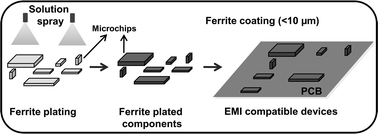Coupling of MnZn-ferrite films onto electronic components by a novel solution process for high frequency applications†
Abstract
A novel approach for the preparation of “coupling-type noise suppressors” in which ferrite films are directly deposited onto the components of the printed circuit board is reported. Crystalline MnxZnyFe3−x−yO4 films were fabricated on IC chips and polyimide substrates by a soft-chemistry route at temperatures below 100 °C. A “reaction-solution” comprising


 Please wait while we load your content...
Please wait while we load your content...